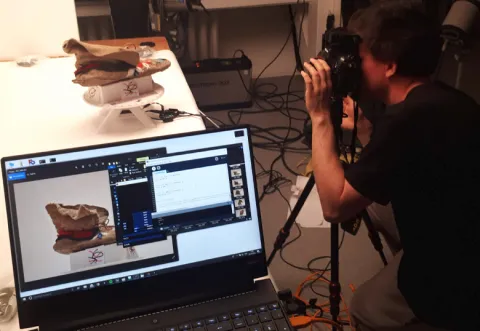University of Lethbridge unveils Mootookakio’ssin website, creates bridge to historical belongings
Utilizing the latest in web technology, the new Mootookakio’ssin website launched today creates a bridge that connects Blackfoot peoples to historical Blackfoot items housed in British museums, thereby reinvigorating a rich, cultural past through in-depth storytelling and laying a foundation to keep the knowledge of Elders alive for future generations.

The culmination of an ambitious and challenging three-year research project, Mootookakio’ssin (moo-DOO-ka-keyo-sin) has brought together University of Lethbridge and United Kingdom (UK) researchers, three British museums, as well as graduate and undergraduate students, all led by Blackfoot advisors and Elders. The result is a stunning, engaging and interactive website that is now a part of the Blackfoot Digital Library and allows users to see and manipulate historical Blackfoot belongings while telling a story that truly brings them to life.
“We use stories to connect with one another and utilizing the story technique allows us to control the narrative about the item and how it is being delivered,” says Melissa Shouting (BHSc ’19), a member of Kainai Nation and a graduate student in the Faculty of Health Sciences. “Storytelling also allows us to showcase who we are as a People, and how we think collectively when it comes to our knowledge systems.”
Shouting is an accomplished beadmaker who, like many Blackfoot artists, can now utilize the incredible detail of the website to see the intricacies of the historical items to guide their own artistic practices. She was part of the delegation that travelled to Britain to document and photograph the historical items housed in British museums.
“One of the reasons I said yes to going there was because we weren’t just going to look at the items and keep that knowledge to ourselves, we were going there to eventually create this website that really illustrates who we are, and then deliver it back to our community,” she says.
Blackfoot Elder Jerry Potts, a key resource throughout the project, says the significance of showing these belongings, some which date back to the 1700s, is immeasurable.
“Some of these items were from the first contact the Blackfeet had with settlers. The material we are looking at was developed before there was any trade, so they were made with quill work and natural dyes,” says Potts. “The Blackfoot People are so tied to nature and the landscape, so you look at these items and try to imagine what they saw. Our culture and our belief system are captured in this art — there’s a lot of value in that.”
Christine Clark (BFA ’10, MFA ’14), professor of new media in the Faculty of Fine Arts, says the group accomplished even more than it set out to with its initial proposal, thanks in large part to the cooperative nature of the project.
“We weren’t sure if we were going to be able to meet all our goals because there were so many unknowns,” she says. “The team dynamics were so important for this project because if any one piece had fallen off, the whole project would have fallen apart.”
Named by Elder Dr. Leroy Little Bear (BASc (BA) '72, DASc '04), Mootookakio’ssin translates to “distant awareness.” The aim is to connect people living in traditional Blackfoot territory with these non-sacred, historical Blackfoot belongings housed in British museum collections. While COVID-19 restrictions limited the workshopping and outreach activities the group had planned initially, they did allow for more intensive work on the website.
“Our primary goal was to design and build a custom site for the 3D material and involve as much storytelling as possible with each piece, and we were able to do that,” adds Clark. “We were also able to incorporate a feature called RTI (reflectance transformation imaging) where you can change the light source to reveal the surface detail on the items. This has definitely been the most multifaceted website I’ve worked on, and I was really lucky to have one of our recent graduates, Calvin Lloyd (BSc ’20), lead the development of this very challenging project.”
Potts sees the website as another small step forward in educating Blackfoot youth and non-Indigenous people alike on the roots of a rich culture, its resilience and how it continues to resonate even today.
“It’s very new and innovative thinking to try and capture this idea and this traditional knowledge and use it to build bridges and understanding,” he says. “It’s a pretty good start and it works because there was a will at the University of Lethbridge and with their researchers to make a difference and they had the right people in the room to give direction to the project. We’ve opened up some doors now with other academics and museums in Britain and that’s really exciting.”
Links
Blackfoot Digital Library: https://www.blackfootdigitallibrary.com/digital/collection/bdl
Mootookakio’ssin website: https://mootookakiossin.ca/
Attached Photos
Mootoo-AwlCase: Blackfoot Awl Case, located in the Museum of Archeology and Anthropology at the University of Cambridge.
Mootoo-BigWhip: Blackfoot weapon, Big Whip, is in the Museum of Archeology and Anthropology at the University of Cambridge.
Mootoo-Moccasin: This moccasin, from a pair with rawhide soles, came from the Piikani First Nation in southern Alberta and is in the Museum of Archeology and Anthropology at the University of Cambridge.
Mootoo-Site: Explore page of the Mootookakio’ssin website
Mootoo-SiteCreation: Photographing and creating a 3D image of a Piikani Moccasin
-- 30 --
Contact:
Trevor Kenney, News & Information Manager
403-360-7639 (cell)
trevor.kenney@uleth.ca
@uLethbridge
